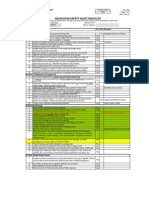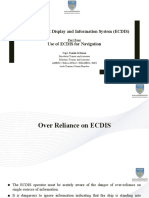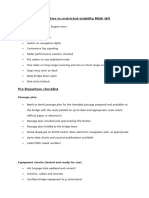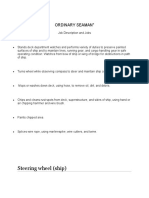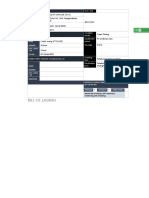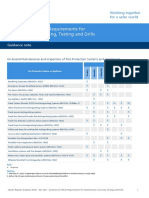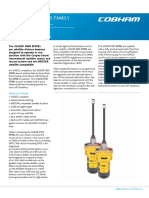0 ratings0% found this document useful (0 votes)
46 viewsBridge Equipment Notes
Bridge Equipment Notes
Uploaded by
nguyenhoanganh181005Copyright:
© All Rights Reserved
Available Formats
Download as DOCX, PDF, TXT or read online from Scribd
Bridge Equipment Notes
Bridge Equipment Notes
Uploaded by
nguyenhoanganh1810050 ratings0% found this document useful (0 votes)
46 views5 pagesOriginal Title
Bridge equipment notes
Copyright
© © All Rights Reserved
Available Formats
DOCX, PDF, TXT or read online from Scribd
Share this document
Did you find this document useful?
Is this content inappropriate?
Copyright:
© All Rights Reserved
Available Formats
Download as DOCX, PDF, TXT or read online from Scribd
Download as docx, pdf, or txt
0 ratings0% found this document useful (0 votes)
46 views5 pagesBridge Equipment Notes
Bridge Equipment Notes
Uploaded by
nguyenhoanganh181005Copyright:
© All Rights Reserved
Available Formats
Download as DOCX, PDF, TXT or read online from Scribd
Download as docx, pdf, or txt
You are on page 1of 5
Ships navigational equipment check - guideline for deck
officers
Collision at sea frequently reported because of substandard bridge
procedures. Lack of checks and testing on bridge equipment can
lead a ship to a dangerous situation. It is especially true while
approaching or leaving a harbor or transiting through a traffic-
congested area with limited sea room. To eliminate the potential
threat of colliding with other vessels or ran aground during shallow
water navigation, bridge watchkeeping officers need to be fully
conversant with the use of all bridge equipment. These preparations
may include many complexities, and this is the reason why a bunch
of things should be considered and prepared carefully, to ensure a
smooth voyage passage and safe navigation.
Prior assuming responsibility of keeping watch deck officers must be
thoroughly familiar with the operation and utilisation of all Bridge
and navigation equipment. It is particularly important that officers
are aware of the limitations of the equipment and of the importance
of not relying solely on one piece of equipment.
Fig: Bridge equipments
Periodic Checks on Navigational Equipment
All Bridge team Members must be aware that equipment breakdown
can occur at any time. Whenever possible, information from one
source must be checked against data from another piece of
equipment. Therefore operational checks on navigational equipment
should be undertaken when preparing for sea and before port entry.
After lengthy ocean passages and before entering restricted coastal
waters, it is vital to check that full engine and steering
maneuverability is available. The OOW should undertake daily tests
and checks on the bridge equipment, including the following:
Manual steering should be tested at least once a watch when
the automatic pilot is in use.
Gyro and magnetic compass errors should be checked once a
watch is possible and after any significant course alteration.
Compass and gyro repeaters should be synchronized, including
repeaters sited away from the bridge, such as in the engine
control room and at the emergency steering position.
Checks on electronic equipment should both confirm that the piece
of equipment is functioning properly and that it is successfully
communicating to any bridge system to which it is connected. Built-
in test facilities provide a useful check on the functional state of the
equipment and should be used frequently. Electronic equipment
systems should be checked to ensure that configuration setting -
important for correct interfacing between pieces of equipment - has
not changed. Information from electronic equipment should always
be compared and verified against information from different
independent sources.
Good practice also requires the OOW to check that orders are being
correctly followed. Rudder angle and engine rpm indicators, for
example, provide the OOW with an immediate check on whether
helm and engine movement orders are being followed.
Emergency procedure for bridge equipment failure
The Shipboard Contingency Plan contains checklists for the failure of
key items of equipment. In the event of failure of any piece of
Bridge equipment, the Master is to be immediately advised. The
Master will then issue clear instructions in the Master’s Bridge Order
Book on procedures to be followed until the equipment can be
restored to operation. Procedures to be followed could involve the
following:
Increased bridge manning;
Hand steering;
Manual plotting of all targets in the event of an ARPA failure;
Use of magnetic compass and the need for additional compass
errors being taken, in the event of main gyro failure;
Use of alternative electronic position fixing by use of Sun and
Stellar observation in the event of GPS failure.
Equipment that cannot be rectified by the ship’s staff must be
reported to the Management Office without delay.Close attention
should be given to all navigational equipments on board cargo
ships .
Bridge equipment periodic check items
Summarized below are some basic check items that need to be
complied by watch officers during navigation at sea
1. Trial of hand steering and comparison of ordered and actual
rudder angles
2. Confirmation of recording conditions of course recorder:
3. Synchronisation of time (shall be set to UTC) & ship's heading
4. Course keeping and steering conditions
5. Remainder of recording paper and print quality
6. Marking of date, ship's time every noon and upon arr/dep port
7. Confirmation of appropriate navigation lights being lit
8. Confirmation of appropriate VHF channel and optimum
volume /squelch setting
9. Confirmation of operation and recording conditions of GMDSS
equipment
10. Confirmation of operation for GPS, Chart plotter and
ECDIS (correct position indicated and datum allowance made if
any)
11. Confirmation of operation and input data for AIS
(navigation, draught, destination, time, power setting, etc)
12. Confirmation of operation of fire detection equipment
(zone isolation- check)
13. Number of steering gear power units in use
14. Measurement and recording of compass error (if unable
to check, record reason in deck log book)
15. Confirmation of synchronization of repeater compasses
and master gyrocompass
16. Comparison of gyro and magnetic compasses (upon
alteration & hourly)
17. Confirmation of operation of Speed Log
18. Confirmation of "M0" operation, start/finish (Reported to
OOW)
19. Execution of alarm and lamp tests of main engine control
console
20. Cargo & bilge monitoring related equipment on bridge
21. Confirmation of error of ship's clocks
22. Testing of non-follow-up steering every noon
23. Check of steering gear at least once a day
24. Testing General alarm & Blowing of whistle at noon
25. Confirmation of set conditions of auto-pilot (course
keeping mode etc)
26. Comparison of both GPS positions & their feed to other
equipment
Confirmation of Radar:
Adjusted conditions of Tune, Clutter (Sea/Rain) & Gain
Proper range in use
Heading and bearing comparison with gyro
Confirmation of ARPA:
Speed input set "through water"
Set values of CPA / TCPA
Vector (true/relative indication)
Set alarm volume level
Operation of echo-sounder (in sounding depths):
1. Adjusted conditions, such as range in use, zero adjustment,
gain adjustment and display output (UKC)
2. Remainder of record paper
3. If recording fuction set on, enter at starting/stopping: date,
time & position and if applicable, range in use
You might also like
- Sea ProjectDocument42 pagesSea ProjectGeri Acosta100% (1)
- 737 Performance Reference Handbook - EASA EditionFrom Everand737 Performance Reference Handbook - EASA EditionRating: 4.5 out of 5 stars4.5/5 (3)
- UK INTERPRETATION Solas Chapter V - Annex 20 - Inspection and Survey of Navigational Equipment PDFDocument33 pagesUK INTERPRETATION Solas Chapter V - Annex 20 - Inspection and Survey of Navigational Equipment PDFboca1966No ratings yet
- Bridge-045-Taking Over The Watch ChecklistDocument1 pageBridge-045-Taking Over The Watch ChecklistMiha Mihaela100% (1)
- Bridge Watch Keeping, Best PracticeDocument40 pagesBridge Watch Keeping, Best PracticeRafi Muiz100% (8)
- Preparation For Arrival / Departure in Port: Action: File and Log, Each TimeDocument2 pagesPreparation For Arrival / Departure in Port: Action: File and Log, Each Timeankit dubey100% (3)
- Bridge Team ManagementDocument3 pagesBridge Team ManagementJeet Singh100% (1)
- Adaptive Autopilot For Marine VesselsDocument6 pagesAdaptive Autopilot For Marine VesselsGAMMA FACULTYNo ratings yet
- Navigation (18Oct24)Document5 pagesNavigation (18Oct24)Alexey LitovchenkoNo ratings yet
- CHAPTER 2Document13 pagesCHAPTER 2kuchkiesNo ratings yet
- NotesDocument5 pagesNotesEthan HuntNo ratings yet
- Act 3 BRAVODocument3 pagesAct 3 BRAVOKaruro SanNo ratings yet
- WatchkeepingDocument19 pagesWatchkeepingsbdman100% (1)
- NP056 Operation and Maintenance of Bridge Equipment Procedure - (JX) - 20120601Document20 pagesNP056 Operation and Maintenance of Bridge Equipment Procedure - (JX) - 20120601jie wuNo ratings yet
- 22 DCL38A Rev 3 Navigation Audit ChecklistDocument4 pages22 DCL38A Rev 3 Navigation Audit ChecklistSunilGangwar83% (6)
- S5.8 Navigational InstrumentsDocument20 pagesS5.8 Navigational InstrumentszikriNo ratings yet
- Deck Log Book EntriesDocument10 pagesDeck Log Book EntriesTùngNo ratings yet
- Bridge Equipment, Watch Keeping and Collision RegulationsDocument67 pagesBridge Equipment, Watch Keeping and Collision Regulationsvishvjeet singhNo ratings yet
- Sample Oceanic ChecklistDocument7 pagesSample Oceanic ChecklistAdriano Bortolin100% (1)
- Sample Oceanic ChecklistDocument7 pagesSample Oceanic ChecklistXana AmaralNo ratings yet
- SIRE 2.0 4.1.12Document2 pagesSIRE 2.0 4.1.12赵一敏No ratings yet
- Use of ECDIS For NavigationDocument37 pagesUse of ECDIS For NavigationAbood AburassNo ratings yet
- Master'S Bridge Standing Orders: MT LadonDocument5 pagesMaster'S Bridge Standing Orders: MT LadonopytnymoryakNo ratings yet
- NAT OPS Bulletin 2012 024Document9 pagesNAT OPS Bulletin 2012 024s_nazirNo ratings yet
- Ships Handling-1Document13 pagesShips Handling-1Leo Keith JocsonNo ratings yet
- 03 Proper Use of Navigation EquipmentDocument52 pages03 Proper Use of Navigation Equipmentsultan.jj7100% (1)
- APEMDocument8 pagesAPEMTushar RathodNo ratings yet
- Unit 1 - Bridge LayoutDocument15 pagesUnit 1 - Bridge Layoutmecete8514No ratings yet
- Bridge Watch Keeping Folr 34Document57 pagesBridge Watch Keeping Folr 34Roshan MaindanNo ratings yet
- Passage Planning SummaryDocument5 pagesPassage Planning Summarythugsdei100% (2)
- 1.17 A List of Main Duties of An Officer On WatchDocument2 pages1.17 A List of Main Duties of An Officer On WatchRitesh JhaNo ratings yet
- NAV 327 F WK 3 4Document29 pagesNAV 327 F WK 3 4Ilove You GamingNo ratings yet
- DutiesDocument7 pagesDutiesTushar RathodNo ratings yet
- Performance Test-The Performance of The Radar Should Be Checked Using The PerformanceDocument2 pagesPerformance Test-The Performance of The Radar Should Be Checked Using The PerformanceSabeena PoonwassieNo ratings yet
- Course Specs DWK II CHEDDocument14 pagesCourse Specs DWK II CHEDReymarr HijaraNo ratings yet
- Bridge, Passage PlansDocument40 pagesBridge, Passage Plansrouteless.captainsNo ratings yet
- Pre Arrival, Departure ChecksDocument5 pagesPre Arrival, Departure ChecksKunalNo ratings yet
- Watch KeepingDocument9 pagesWatch KeepingJonieLachicaNo ratings yet
- Steering Control SystemsDocument23 pagesSteering Control Systemsdonato del rosario100% (1)
- CH 04 Record KeepingDocument7 pagesCH 04 Record KeepingAmit PandeyNo ratings yet
- S Navigation TheoryDocument89 pagesS Navigation TheoryThulasi RamanNo ratings yet
- PEV 1 - Principii PEV - 2022Document23 pagesPEV 1 - Principii PEV - 2022Micro BuzNo ratings yet
- Appraisal: Process of Gathering All Information RelevantDocument32 pagesAppraisal: Process of Gathering All Information Relevantyxone acedo100% (2)
- NAV1-Navigation Checklist - 1Document1 pageNAV1-Navigation Checklist - 1Shreedeep Jyothi MajumderNo ratings yet
- BPG Mandy PDFDocument8 pagesBPG Mandy PDFMandy ConquersNo ratings yet
- 1 Aguilario Kin Ian P. Dw2 Laboratory 2 3Document3 pages1 Aguilario Kin Ian P. Dw2 Laboratory 2 3Anjo TubocNo ratings yet
- Os ReviewerDocument9 pagesOs ReviewerBen Jie CabahugNo ratings yet
- CL 2Document1 pageCL 2mehedi2636No ratings yet
- Guidelines On Annual Testing of Voyage Data Recorders (VDR) and Simplified Voyage Data Recorders (S-VDR)Document7 pagesGuidelines On Annual Testing of Voyage Data Recorders (VDR) and Simplified Voyage Data Recorders (S-VDR)Lucas BarriosNo ratings yet
- Chapter 07.02 Navigation - Appendix III - Standing Orders Guidance 09-12-2017Document11 pagesChapter 07.02 Navigation - Appendix III - Standing Orders Guidance 09-12-2017hunghm.pvdiNo ratings yet
- Check List Expanded VersionDocument7 pagesCheck List Expanded VersionRusshzel PauleNo ratings yet
- Preparation For Sea VoyageDocument3 pagesPreparation For Sea VoyageDavid Nazareth100% (1)
- 12 Communicating With The Engine RoomDocument17 pages12 Communicating With The Engine Roomsultan.jj7No ratings yet
- Master Pilot ExchangeDocument5 pagesMaster Pilot ExchangeBehendu PereraNo ratings yet
- UR N pdf156Document10 pagesUR N pdf156harikrishnanpd3327No ratings yet
- Nav Essay 300 Words EachDocument4 pagesNav Essay 300 Words Eachtoledo.arvingarret.pntcNo ratings yet
- 15 VIQ With Regard To ECDISDocument39 pages15 VIQ With Regard To ECDISJoel Cargo100% (1)
- 2m Orals 2Document26 pages2m Orals 2Leena Pathak Juyal100% (1)
- AIR CRASH INVESTIGATIONS - THE BOEING 737 MAX DISASTER PART 1 - The Crash of Lion Air Flight 610From EverandAIR CRASH INVESTIGATIONS - THE BOEING 737 MAX DISASTER PART 1 - The Crash of Lion Air Flight 610No ratings yet
- Holcobatch Green 11-30-24368 - Safety Data Sheet (SDS), EU - v1.0Document9 pagesHolcobatch Green 11-30-24368 - Safety Data Sheet (SDS), EU - v1.0Hendra SeptaNo ratings yet
- Unit 8Document8 pagesUnit 8fernando iturri tellezNo ratings yet
- MST Water Pipe RelocationDocument29 pagesMST Water Pipe Relocationslayerzzz22No ratings yet
- BILL OF LADING-dikonversiDocument2 pagesBILL OF LADING-dikonversiillhamNo ratings yet
- HSE Plan-TDDocument52 pagesHSE Plan-TDPeshteenNo ratings yet
- LATEST AMENDMENTS - Brochure BV IMO 2023-2024Document13 pagesLATEST AMENDMENTS - Brochure BV IMO 2023-2024abbyuvNo ratings yet
- Kippap Handout - DPWH Highway Safety Design Standards 1Document8 pagesKippap Handout - DPWH Highway Safety Design Standards 1Erwin AlcaireNo ratings yet
- PCG FormE5Man - OverboardDocument8 pagesPCG FormE5Man - Overboardjohn mark manuel magalonaNo ratings yet
- Milwaukee GOP 2024 Convention Complex MapDocument1 pageMilwaukee GOP 2024 Convention Complex MapjroneillNo ratings yet
- Man Overboard - Manoeuvers You Need To Know To Save A LifeDocument4 pagesMan Overboard - Manoeuvers You Need To Know To Save A LifeGiorgi KandelakiNo ratings yet
- Ship Masters Handbook Web VersionDocument36 pagesShip Masters Handbook Web VersionDrazen RihaNo ratings yet
- Mercedes C230 Operators ManualDocument442 pagesMercedes C230 Operators ManualchacalextremeNo ratings yet
- Life - Line ECMO Sell - Sheet ECMO FEB22 1 WebDocument2 pagesLife - Line ECMO Sell - Sheet ECMO FEB22 1 WebJavier Dario Cifuentes SandovalNo ratings yet
- G9 Iriset Disaster ManagementDocument78 pagesG9 Iriset Disaster ManagementRAHUL SINGHNo ratings yet
- Heli+Fleet+Report+2019+ +enDocument76 pagesHeli+Fleet+Report+2019+ +enAtiesh Mishra100% (1)
- Bridge WatchkeepingDocument9 pagesBridge WatchkeepingjosephvjNo ratings yet
- S40 QuickGuide MY07 EN TP8585Document8 pagesS40 QuickGuide MY07 EN TP8585OlegNo ratings yet
- 1.1 Lifesaving Equipment Test/Inspection and Renewal Dates: Next DueDocument1 page1.1 Lifesaving Equipment Test/Inspection and Renewal Dates: Next DueJosipBatinovićNo ratings yet
- 502 A2025 ROA AAA FD PIResponsesDocument65 pages502 A2025 ROA AAA FD PIResponsesMatias Concha PalaciosNo ratings yet
- Summary of SOLAS Requirements For Maintenance, Servicing, Testing and DrillsDocument3 pagesSummary of SOLAS Requirements For Maintenance, Servicing, Testing and DrillsJuanNo ratings yet
- OMTD25MS1T4FSV20V2EDocument284 pagesOMTD25MS1T4FSV20V2EOli MijanaNo ratings yet
- CV Sulfi Marhaban IvopsDocument1 pageCV Sulfi Marhaban IvopsSulfi Marhaban57No ratings yet
- Night Work PDFDocument1 pageNight Work PDFBala VelmuruganNo ratings yet
- Euroferry Olympia - InterimDocument15 pagesEuroferry Olympia - InterimigeorgievntibNo ratings yet
- Heliport and Stolport and SMSDocument34 pagesHeliport and Stolport and SMSDebendra Dev KhanalNo ratings yet
- Sailor Epirb 4065 FamilyDocument2 pagesSailor Epirb 4065 FamilyDidier GassNo ratings yet
- Ecodes PDFDocument2 pagesEcodes PDFVladimir233No ratings yet
- MLC MHL Mi-118 202108Document74 pagesMLC MHL Mi-118 202108oma0191No ratings yet
- Use of Highway and Rules of The Road Regulation: Traffic Safety ActDocument76 pagesUse of Highway and Rules of The Road Regulation: Traffic Safety ActHENRY FORDNo ratings yet
- Unit 3 Describing An AccidentDocument13 pagesUnit 3 Describing An AccidentDANo ratings yet














